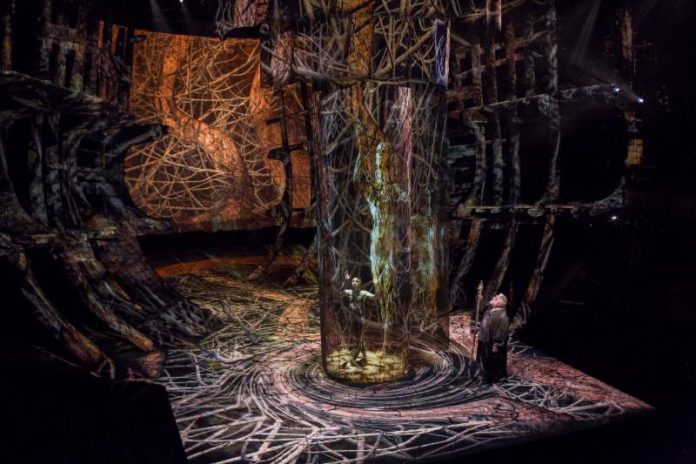Adam Young and Finn Ross, founders of Olivier Award-winning visual storytelling outfit, FRAY Studio are the creators of the much-talked-about video environments showcasing in the current Royal Shakespeare Company (RSC) production of The Tempest, now on at The Barbican in London.
FRAY worked in collaboration with Intel and in association with The Imaginarium Studios on the production’s highly-acclaimed stagecraft, described by The Financial Times as ‘State-of-the-art’ and by the Daily Telegraph as ‘true to the hype of breath-taking order’. Known to have a considered approach to modern stagecraft, FRAY has designed for critically acclaimed theatre productions including The Curious Incident of the Dog in the Night-Time and Harry Potter and the Cursed Child. For The Tempest, FRAY designed, produced and mapped the show’s rich onstage video sets.
“When we began working on the video environments for The Tempest we took a lot of inspiration from the pastoral work of British and Irish artists,” says Finn. “We looked at Turner, Francis Bacon, Romantic artist John Constable and most notably David Hockney.” Hockney became a key figure in FRAY’s creative approach to the production. The 20th Century artist’s exploration of the fantastical within the natural in his large scale work provided the studio’s creative springboard for The Tempest’s video environments. “Plays can be very literal,” informs Finn. “We had to build first on that and then design out of it. An example where we could really explore this was the Masque scene. The world of The Tempest up until that point is a muted, moody place. The Masque goes into this mad, huge world of glorious colour and painted loveliness. “For this, we decided to move from the very Turner and Constable-esque world of the island into a vivid, Hockney-inspired, graphic, bonkers-crazy world. During the scene, magic has to come alive and breathe in the space. It is a brilliant exercise in abstraction. A great show of nature in abundance.”
An unexpected parallel for FRAY was discovering Hockney’s creative drive to look for what is fantastical and once that is done, what is possible. It’s a philosophy that drives the studio’s approach not only to their work but to the over-arching development of creative content design. “We are not afraid of new technology,” says Finn. “Since the early days of media servers, FRAY has been involved with manufacturers, working with them to shape products that expand the boundaries of video design, because we do not feel intimidated by new technology, we know how to apply it meaningfully.”
To do this FRAY flips its design approach, moving from ‘what would stand out if it was there?’ to ‘what would stand out if it was not there?’. “It’s about understanding the moment you are creating content for, and crafting a response to it that fits,” says Adam. “In The Tempest’s shipwreck scene we used video assist to create a sense of chaos. We also filmed water and created a stylised animation designed to fit and flow around The Tempest set, drawing in the audience to the stress and overwhelming feeling of the scene.”
Working with RSC Artistic Director Gregory Doran and RSC production designer Stephen Brimson Lewis, FRAY developed a modular workflow for The Tempest that would accommodate collaboration between the production’s different creative teams.
On this process Adam says, “The Tempest’s ‘stage picture’ is made up of multiple elements, the floor, ship’s ribs, the back cyclorama, table projection and the central moving vortex. Working in a modular way is key to the process of collaboration as it allows us to respond very quickly to creative developments. We can offer up different options for a scene by taking a mix-and-match approach. For The Tempest, it allowed us alongside the RSC’s creative team to try out ideas and give a real-time sense of what worked and what didn’t during technical rehearsals.”
The Tempest was originally staged at the RSC in Stratford-upon-Avon as part of their artistic programme marking last year’s 400th anniversary of Shakespeare’s death. The production transferred from the Royal Shakespeare Theatre where it ran between 18 November 2016 – 21 January 2017 to The Barbican in London where it will run until 18 August 2017.





